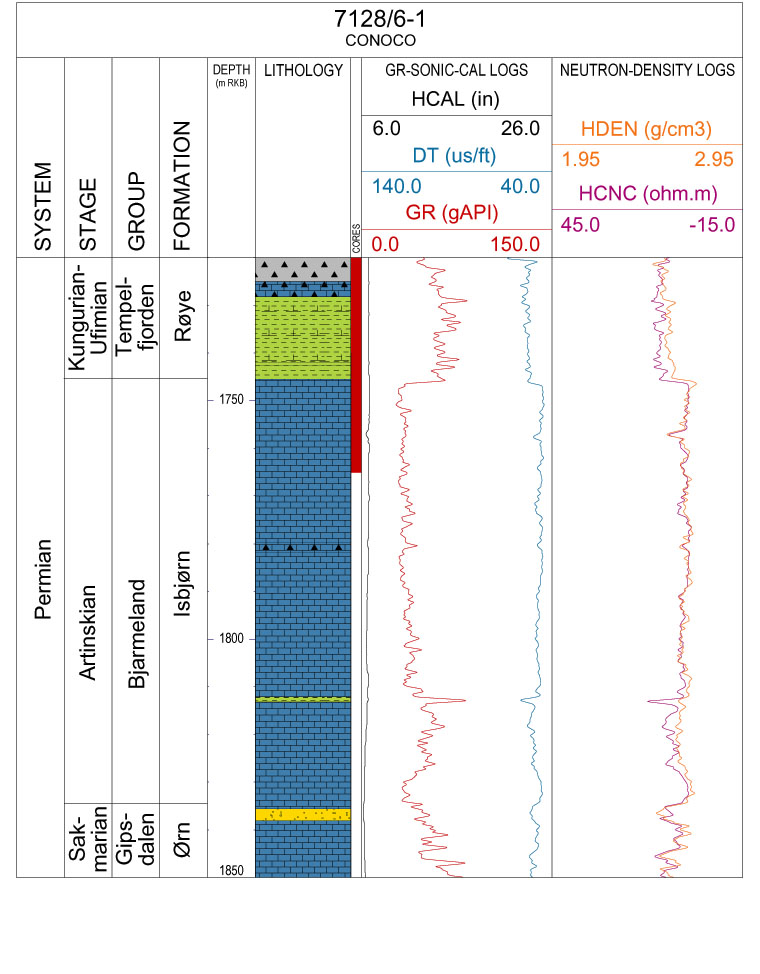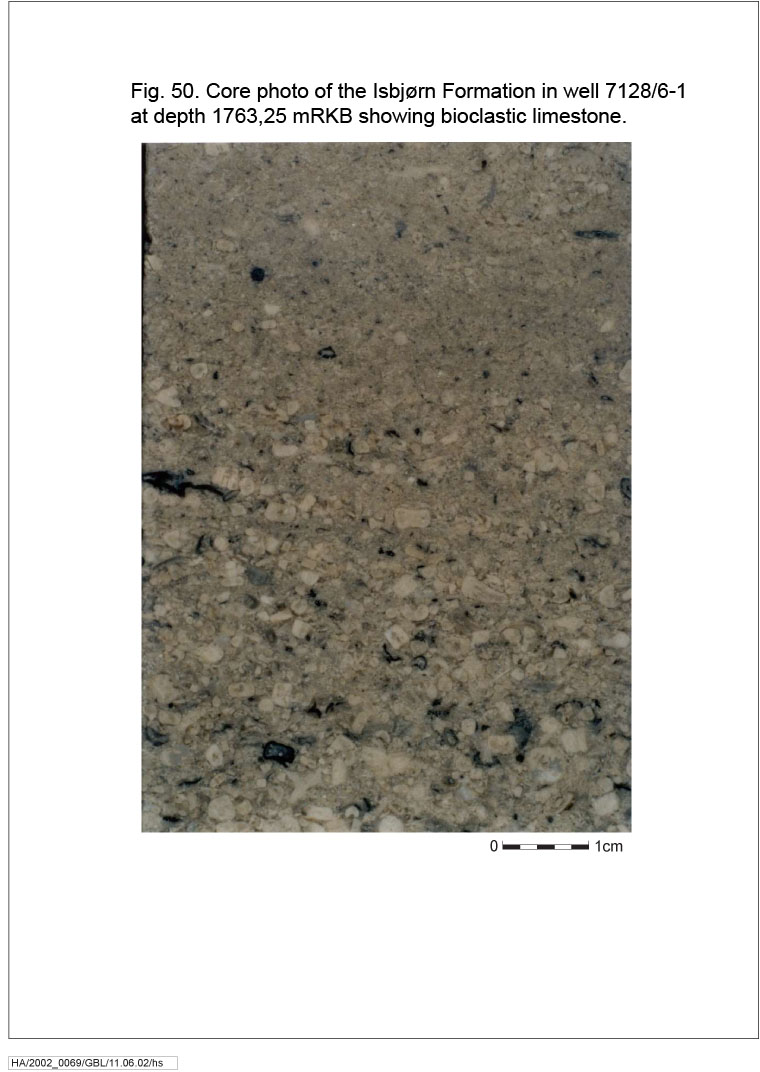IsbjГёrn Formation (IsbjГёrnformasjonen)
Name:
From the Norwegian name for the Polar Bear (Ursus maritimus).
Definition:
The type section is defined as the interval from 1834.7 m to 1745.4 m in well 7128/6-1 on the Finnmark Platform (Fig. 48), apparently concurring with informal unit L-8 of Ehrenberg et al. (1998a). Cores cover the entire section (Fig. 49). In this well the base of the formation is marked by a decrease in gamma ray response, reflecting the transition from silty warm water carbonates to clean cool-water carbonates.
Fig. 48. Well logs of the type section of the IsbjГёrn Formation in 7128/6-1.
For explanation of symbols see Fig. 3.

Fig. 49. Sedimentological log of the core through the entire type section of the IsbjГёrn Formation in well 7128/6-1.
For explanation of symbols see Fig. 3.

Reference sections:
A reference section is defined as the intervals from 3700 m to 3625 m and 3586 m to 3502 m in well 7121/1-1 on the Loppa High, these intervals interfingering with Ulv Formation lithofacies (Fig. 43). A small core, 2,7 m long, exists from the uppermost part of the formation, between 3513.7 m and 3511.0 m. An additional reference section is designated in 7229/11-1 (4046 m to 3970 m), where the IsbjГёrn Formation rests directly on carbonate buildups of the Polarrev Formation. The uppermost part of the formation has been drilled in the southernmost part of the Finnmark Platform (cores 7128/12-U-01 from 569.2 m to 557.5 m and 7129/10-U-01 from 475.3 m to 464 m) (Bugge et al. 1995).
The base is not easy to pick on logs in areas where the formation rests directly on the Polarrev Formation (e.g. 7229/11-1), as the boundary there represents a limestone- limestone contact (Fig. 39). It is recognised by a slight decrease in interval transit time and neutron porosity log values accompanied by an increase in bulk density in wells 7121/1-1 and 7229/11-1. However, over the buildups, the base of the formation is easily picked on seismic data. In 7121/1-1 the transition from the interfingering Ulv Formation up into the IsbjГёrn Formation shows a marked decrease in gamma ray response, reflecting the transition from silty wackestones into cleaner packstones and grainstones (Fig. 43).
Thickness:
The formation is approximately 75-90 m thick in the central and northern parts of the Finnmark Platform, thinning to 10 m in the IKU cores. It is slightly thinner in 7124/3-1 and absent from the outer shelf environments represented by the Ulv Formation in 7226/11-1 on the Bjarmeland Platform (Fig. 38). The formation is thickest in 7121/1-1 on the southeastern flank of the Loppa High, where its two intercalations have a composite thickness of approximately 160 m (Fig. 43).
Lithology:
Bedded, white to light grey bioclastic limestones with a fauna of mainly crinoids and bryozoans dominate the formation. The dominant facies are grainstones and packstones (Fig. 50). The formation has a characteristic low gamma ray response throughout, except for thin intervals of dark grey silty wackestone that represent temporary deeper water deposition related to flooding events. Chert nodules occur sporadically throughout the section. The dark grey silty limestone intervals are lithologically similar to the Ulv Formation but are regarded as part of the IsbjГёrn Formation if they are of subordinate importance and less than 15-20 m thick. Thicker intervals such as that from 3625 m to 3586 m in well 7121/1-1 are included in the Ulv Formation.

Lateral extent and variation:
The formation represents deposition in inner shelf environments. Following a major transgression in the early Artinskian the formation developed over earlier carbonate buildups and submerged structural highs and platforms. The formation is not known from either outer shelf regimes or from basinal areas.
Age:
The base of the formation is apparently diachronous. In the type section in 7128/6-1 fusulinids suggest that the base is of mid-Sakmarian age and the top is late Artinskian (Ehrenberg et al. 1998a). In well 7229/11-1 the top of the underlying Polarrev Formation is dated as late Sakmarian, indicating a late Sakmarian or younger age for the formation in this well (Davydov 1998). The formation is apparently of late Artinskian age in IKU cores (Bugge et al. 1995).
Depositional environments:
The bioclastic crinoid- and bryozoan- dominated grainstones and packstones of the IsbjГёrn Formation represent deposition in inner shelf environments on cool-water carbonate platforms (Stemmerik 1997). The more silty wackestone facies represent temporary flooding and deposition in slightly deeper environments below storm wave base.
Correlation:
The upper part of the IsbjГёrn Formation correlates age- and facies-wise with the Hambergfjellet Formation on BjГёrnГёya and with the VГёringen Member of the Kapp Starostin Formation on Spitsbergen.
